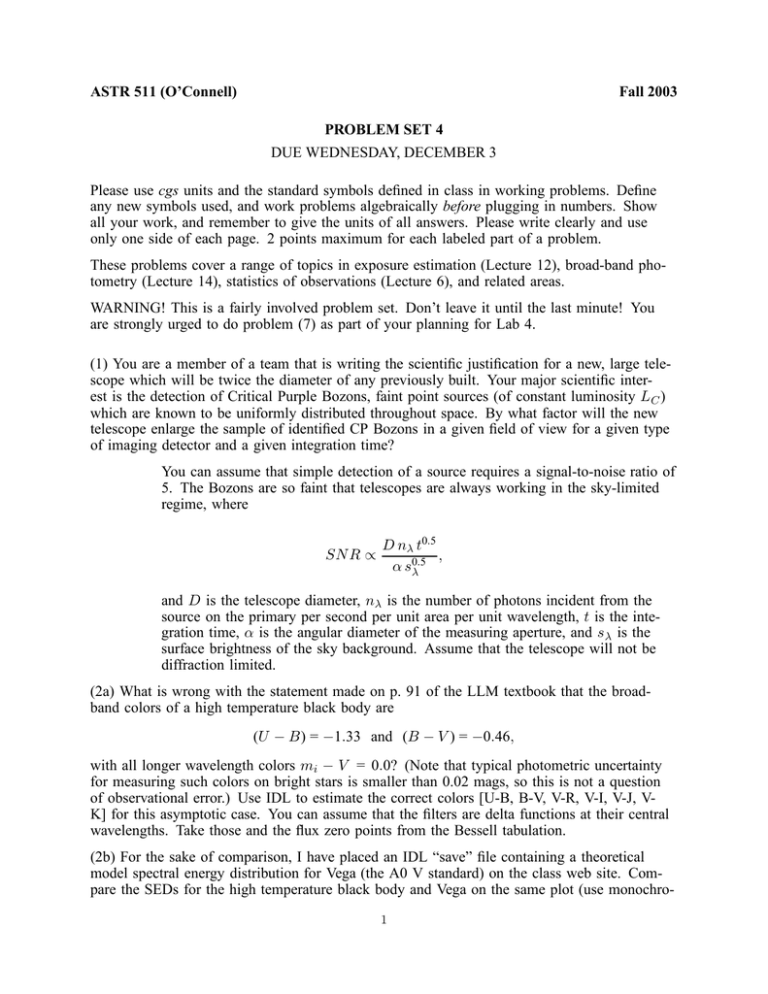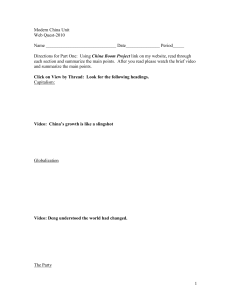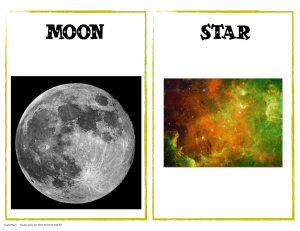ASTR 511 (O’Connell) Fall 2003 PROBLEM SET 4 DUE WEDNESDAY, DECEMBER 3
advertisement

ASTR 511 (O’Connell) Fall 2003 PROBLEM SET 4 DUE WEDNESDAY, DECEMBER 3 Please use cgs units and the standard symbols defined in class in working problems. Define any new symbols used, and work problems algebraically before plugging in numbers. Show all your work, and remember to give the units of all answers. Please write clearly and use only one side of each page. 2 points maximum for each labeled part of a problem. These problems cover a range of topics in exposure estimation (Lecture 12), broad-band photometry (Lecture 14), statistics of observations (Lecture 6), and related areas. WARNING! This is a fairly involved problem set. Don’t leave it until the last minute! You are strongly urged to do problem (7) as part of your planning for Lab 4. (1) You are a member of a team that is writing the scientific justification for a new, large telescope which will be twice the diameter of any previously built. Your major scientific interest is the detection of Critical Purple Bozons, faint point sources (of constant luminosity L C ) which are known to be uniformly distributed throughout space. By what factor will the new telescope enlarge the sample of identified CP Bozons in a given field of view for a given type of imaging detector and a given integration time? You can assume that simple detection of a source requires a signal-to-noise ratio of 5. The Bozons are so faint that telescopes are always working in the sky-limited regime, where SN R ∝ D nλ t0.5 , α sλ0.5 and D is the telescope diameter, nλ is the number of photons incident from the source on the primary per second per unit area per unit wavelength, t is the integration time, α is the angular diameter of the measuring aperture, and s λ is the surface brightness of the sky background. Assume that the telescope will not be diffraction limited. (2a) What is wrong with the statement made on p. 91 of the LLM textbook that the broadband colors of a high temperature black body are (U − B) = −1.33 and (B − V ) = −0.46, with all longer wavelength colors mi − V = 0.0? (Note that typical photometric uncertainty for measuring such colors on bright stars is smaller than 0.02 mags, so this is not a question of observational error.) Use IDL to estimate the correct colors [U-B, B-V, V-R, V-I, V-J, VK] for this asymptotic case. You can assume that the filters are delta functions at their central wavelengths. Take those and the flux zero points from the Bessell tabulation. (2b) For the sake of comparison, I have placed an IDL “save” file containing a theoretical model spectral energy distribution for Vega (the A0 V standard) on the class web site. Compare the SEDs for the high temperature black body and Vega on the same plot (use monochro1 matic magnitudes with offsets as appropriate). Interpret the results of (2a) in terms of this plot. Submit a hardcopy of the plot. (3) Estimate the surface brightness of the Earth’s sky at 10µ. Assume the atmosphere is planeparallel, emits like a uniform black body at T = 250 K and has an optical depth at the observatory’s altitude of τ (10µ) = 0.3. Express your answer in units of ergs s −1 cm−2 Å−1 per square arc-sec. Compare the brightness of the atmosphere in a 10 arc-sec circular aperture to the brightness of Vega at 10µ (assume that Vega emits like a black body at 10µ, and has V = 0.03 and Te = 9550). [Alternatively, use the fluxes in the Vega IDL “save” file.] Since the sky brightness at 10µ is highly variable, what does this comparison suggest about the value of being able to observe at 10µ with an array detector, which simultaneously measures the target and the background? (4a) The scandalous spherical aberration discovered to be present in the main optics of the Hubble Space Telescope when it was first launched seriously affected some science programs. Here, you are asked to estimate its impact on faint point source detection with the CCD detectors in the Wide Field Camera. Adopt the following parameters: primary diameter 2.4-m; focal ratio of the WFC f /12.9; total system throughput at 5500 Å (including filter and CCD) 15%; pixel size 15µ; readout noise per pixel 13 electrons rms; sky background 23 mag per arcsec 2 . Ignore dark counts, flat field effects, cosmic rays, and bias noise. State any other assumptions you make. Assume that the telescope without the aberration was effectively diffraction limited in the V band, with the Airy disk containing 70% of the light. (Ideally, it would contain 86%.) Estimate the corresponding limiting V magnitude for a 60-minute integration time. The limiting magnitude is defined as the magnitude of a star yielding a signal-to-noise ratio of 5 within the 70% encircled energy diameter. (4b) In the presence of aberration, the 70% encircled energy diameter became 2.8 00 at 5500 Å. Estimate the change in limiting V magnitude which resulted from this increase in image diameter. (5) It is easier to detect a source of a given luminosity against the sky background if its radiation is confined to a narrow emission line. Suppose there are two distant (point) sources, each with the same integrated luminosity L. One is a continuum source with the light spread uniformly over a 1000 Å bandwidth. The other is an emission line source with the same luminosity confined to a narrow spectral feature which can be contained within an interference filter of 50 A bandwidth. You are observing under sky-limited conditions. For a given signal-to-noise ratio, what is the ratio of detection distances for the two sources? (6a) The FITS file “synthimage.fits" contains a simulation of an image of an extended source seen against a moderate sky background. The image has been subjected to a large number of “cosmic ray hits” (individual anomalously bright pixels). In this problem you will assess the statistics of the background and measure the brightness of the source. Use IDL to solve this problem. Keep an annotated journal file of your work. Turn in hardcopies of the plots marked “**” below. Read the FITS file, display the image, and inspect it however you wish. **Plot a histogram of 2 all image values. Use histogramming or other inspection techniques to determine the approximate pixel values of the three components. What are they? (6b) Sample the background using 5 pixel samples. Repeat 100 times; plot the histogram of resulting sample means. What is the estimate of the mean sky flux per pixel? What is the standard error of the mean? (6c) Sample the background using 25 pixel samples. Repeat 100 times; plot the histogram of the resulting sample means. What is the estimate of the mean sky flux per pixel? What is the standard error of the mean? How does it compare to the 5x100 case? Compare the width of the two distributions in a single histogram **plot. (6d) Devise an “outlier rejection” method to remove the effects of the CR’s from the sampling. Clearly explain your algorithm. Incorporate this in an IDL subroutine procedure named "outlier.pro". Rerun the 25x100 sampling with CR rejection; determine the corrected sky mean and its standard error. **Plot a histogram of the resulting sample means. (6e) Finally, sample the source using outlier rejection. What is the mean flux of the source per pixel after sky subtraction? What is the standard error in the mean flux estimate? (7a) Compute the limiting magnitude of the Fan Mountain 1-m CCD system for detecting point sources as follows. Assume a net throughput (optics, filter, CCD) of 20% for a V-band filter with a FWHM of 800 Å. Assume an effective primary diameter of 90 cm. Ignore flatfield uncertainties, dark current, read noise, and bias noise in your estimates. Write an IDL subroutine procedure to perform the basic integration time calculations, using an appropriate set of required or optional (keyword) input parameters. The routine should be able to accommodate both of the calculations requested below. For a first calculation, ignore the sky background. Calculate the integration times necessary to achieve SN R = 10 in the source flux for stars with V-magnitudes between 5 and 25. Repeat the calculations for SN R = 100. Show the results of both calculations on the same plot in the form of stellar magnitude versus log t. Also tabulate the results every 2.5 magnitudes in 3 columns: magnitude, t(SN R = 10), t(SN R = 100). (A simple ASCII printout is OK.) (7b) Now include the effects of the sky background, assumed to be µ V = 21 mag arcsec−2 . Assume you will measure the star’s flux in an aperture 10 square arc-seconds in area and the sky background separately in a 10 square arc-second aperture. Produce the same kinds of output products as for (a). If the longest integration time possible, under reasonably stable photometric conditions (including CCD bias drift), is 2000 seconds, how faint a star can you measure at the two specified SNR’s? (7c) Each of the three Lab 4 groups is planning broad-band imaging of stellar sources. Use your plots to estimate the integration time needed to reach the appropriate SN R for typical sources in your particular program. [Submit hardcopies of the appropriate plots and tables, a printout of your IDL procedure, and a copy of the journal files for the final computational runs. ] 3




